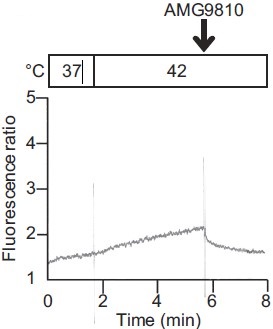Overview
- Vriens, J. et al. (2009) Mol. Pharmacol. 75, 1262.
 Alomone Labs AMG 9810 inhibits Olvanil-activated TRPV1 channels heterologously expressed in C-6 cellsCells were loaded with Fluo-3 AM and changes in intracellular Ca2+ was measured. Normalized fluorescence before (control, gray dotted line) and after application of 10 µM Olvanil (#O-115), either without or after incubation with 1 µM and 10 µM AMG 9810 (#A-180), black lines as indicated.
Alomone Labs AMG 9810 inhibits Olvanil-activated TRPV1 channels heterologously expressed in C-6 cellsCells were loaded with Fluo-3 AM and changes in intracellular Ca2+ was measured. Normalized fluorescence before (control, gray dotted line) and after application of 10 µM Olvanil (#O-115), either without or after incubation with 1 µM and 10 µM AMG 9810 (#A-180), black lines as indicated.
AMG 9810 (E)-3-(4-t-butylphenyl)-N-(2, 3- dihydrobenzo [b] [1,4] dioxin-6-yl) acrylamide is a potent, non-vanilloid, competitive antagonist of the vanilloid receptor 1 (TRPV1) with IC50 values for human TRPV1 of 24.5 nM and rat TRPV1 of 85.6 nM.
Additionally, it has been shown to compete with other modes of TRPV1 activation, including protons (IC50s = 92.7 and 294 nM for human and rat, respectively), heat (IC50s = 15.8 and 21 nM for human and rat, respectively), and the endogenous ligands anandamide, N-arachidonoyl dopamine (IC50s = 8.5 and 260 nM for human and rat, respectively), and oleoyldopamine.
Furthermore, AMG 9810 blocks capsaicin-induced calcitonin gene-related peptide (CGRP) release and capsaicin-evoked depolarization in rat dorsal root ganglia neurons.
Finally, AMG 9810 was shown to be a potent and selective antagonist of TRPV1 that can significantly reverse thermal and mechanical hyperalgesia in an animal model of inflammatory pain1.

Alomone Labs AMG 9810 inhibits TRPV1 endogenously expressed in mouse C2C12 myoblasts.Calcium influx in myoblast cells cultured with 0.9 mM CaCl2 at 37°C, exposed to 42°C, and then treated with AMG 9810 (#A-180). Calcium influx was increased by exposure to 42°C and decreased by treatment with AMG 9810.Adapted from Obi, S. et al. (2017) J. Appl. Physiol. 122, 683. with permission of The American Physiological Society.

